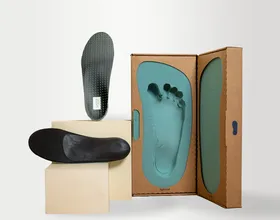Coping with Foot Problems in Pregnancy: Guide for Pregnant Women
Discover relief for common foot ailments during pregnancy. Our guide offers practical tips and solutions to keep you comfortable and mobile throughout your journey
Updated December 9, 2024.

Pregnancy is a magical journey filled with anticipation and wonder. As your body undergoes incredible transformations to accommodate your growing baby, it's easy to focus on the obvious changes. But, the often-overlooked discomfort of swollen, aching feet can significantly impact your overall well-being.
This guide will explore common foot problems during pregnancy and provide practical solutions to help you enjoy a more comfortable nine months.
» Find relief from pregnancy-induced foot issues with custom insoles
Understanding Changes During Pregnancy
As your body prepares for childbirth, it releases a hormone called relaxin, which helps by loosening ligaments and joints. While this is necessary for delivery, it also affects other body parts. The increased flexibility in your ankle tendons can lead to joint instability.
As the baby grows, the additional weight gain is concentrated in your stomach, shifting your center of mass forward. This puts more pressure on your forefoot, changing your walking mechanics and causing a "pregnancy waddle," especially in the third trimester. [1]
» Learn more about the anatomy of the foot
Common Foot Issues During Pregnancy
One of the most prevalent foot problems during pregnancy is plantar fasciitis, which causes pain in the heel or arch of the foot. Edema, or swelling, can also cause discomfort and make fitting into your regular shoes challenging. Various forms of tendonitis in the calf and ankle are also frequently reported.
The combination of hormonal changes, weight gain, and altered biomechanics can lead to overpronation, where the foot rolls inward. [2] This can cause strain on the ligaments and joints of the foot, potentially leading to pain and discomfort.
» Explore the difference between collapsed arches and flat feet
The Importance of Proper Footwear
To help prevent foot problems, avoid shoes that lack the necessary structure to support your changing feet. Try to avoid the following, especially in the second and third trimesters:
- Flip-Flops: While convenient, they offer minimal support and can lead to overpronation and strain on the plantar fascia.
- High Heels: Shifting your weight forward increases pressure on your forefoot and potentially causes balance issues.can
- Ballet Flats: Though comfortable, they typically lack arch support and can contribute to foot fatigue.
- Slip-On Shoes: Many lack proper heel support and can cause your feet to slide around, affecting stability.
Instead, opt for shoes that provide:
- Good Arch Support: This helps distribute your weight evenly across your foot, reducing strain on your arches and preventing overpronation.
- Wide Toe Box: As your feet may swell during pregnancy, a wider toe box provides ample space for your toes to spread naturally, improving balance and comfort.
- Ample Cushioning: Shock-absorbing cushioning helps protect your joints from the impact of walking and standing.
- Adjustable Fit: Look for shoes with laces, straps, or Velcro closures to accommodate changes in foot size and orthotics.
» Check out how insoles provide extra arch support
The Role of Orthotics and Inserts
Orthotics are specially designed shoe inserts that support and align your feet. During pregnancy, they can be particularly beneficial in managing the increased stress on your feet and lower limbs.
Key benefits of orthotics during pregnancy include:
- Enhanced Comfort: As weight shifts and hormonal changes relax ligaments, orthotics provide crucial arch support, preventing overpronation and cushioning the forefoot. This reduces strain on the feet, ankles, and lower back.
- Improved Balance and Stability: Proper foot alignment, facilitated by orthotics, contributes to better balance and stability, which is essential as your center of gravity changes.
- Pain Prevention and Relief: Orthotics can help prevent common pregnancy-related foot ailments such as plantar fasciitis, heel pain, and metatarsalgia. [3] They also relieve existing foot conditions like flat feet or high arches.
- Overall Well-Being: Promoting comfort and reducing pain can enhance your overall well-being and make daily activities easier to manage during pregnancy.
» Discover whether custom orthotic insoles are worth it
Tips for Preventing Foot Issues During Pregnancy
Here are some tips to keep your feet happy and healthy:
Manage Swelling
- Elevate Your Feet: Prop them up on a footrest or pillow whenever possible. This helps reduce fluid buildup.
- Stay Active: Gentle exercises like ankle pumps, circles, and toe writing improve circulation and combat swelling.
- Hydrate: While it might seem counterintuitive, drinking plenty of water helps regulate fluid balance.
» Tired feet? Check out the amazing benefits of rolling your feet
Strengthen Your Feet
- Foot Yoga: Exercises like lifting individual toes and moving them independently strengthen the often-neglected foot muscles.
- Ankle Activation and Stability: To support your ankles, practice inward and outward rotations, up-and-down movements, and balance challenges.
» Explore exercises to strengthen your feet and ankles
Prioritize Foot Hygiene
- Regular Inspections: Check your feet for redness, soreness, or unusual changes daily.
- Keep Them Clean and Dry: Wash your feet daily and moisturize them to prevent dryness and cracking.
- Seek Assistance: As your belly grows, you might need help looking at hard-to-reach areas.
» Find out how to stretch the arch of your foot
While some foot discomfort is normal during pregnancy, persistent pain or significant changes in your feet should be evaluated by a podiatrist. A foot specialist can diagnose specific issues and provide tailored treatment recommendations.
Protect Your Feet, Boost Your Comfort
A proactive approach to foot health is essential for maintaining comfort and enjoying a healthy pregnancy. Hormonal and physical changes can significantly impact your feet, causing discomfort and altering your shoe fit. Instead of completely overhauling your shoe collection, consider the benefits of orthotics.
They offer exceptional support and cushioning, adapting to your feet as they change throughout pregnancy. By correcting alignment and relieving pressure points, orthotics can alleviate pain, reduce injury risk, and extend the lifespan of your favorite footwear.
» Prevent pregnancy-related foot problems with custom insoles
References
N. N. Rodriguez, S. Soares, and A. Seidel, “Pathologies du pied et de la cheville pendant la grossesse,” Revue Médicale Suisse, vol. 20, no. 866, pp. 607–610, Jan. 2024, doi: 10.53738/revmed.2024.20.866.607. Available: https://pubmed.ncbi.nlm.nih.gov/38506464/#:~:text=A%20range%20of%20hormonal%20and,pain%2C%20oedema%2C%20and%20fractures.
[2] M. Alcahuz-Griñan, P. Nieto-Gil, P. Perez-Soriano, and G. Gijon-Nogueron, “Morphological and Postural Changes in the Foot during Pregnancy and Puerperium: A Longitudinal Study,” International Journal of Environmental Research and Public Health, vol. 18, no. 5, p. 2423, Mar. 2021, doi: 10.3390/ijerph18052423. Available: https://pubmed.ncbi.nlm.nih.gov/33801299/
[3] M. Gimunová, M. Zvonař, M. Sebera, P. Turčínek, and K. Kolářová, “Special footwear designed for pregnant women and its effect on kinematic gait parameters during pregnancy and postpartum period,” PLoS ONE, vol. 15, no. 5, p. e0232901, May 2020, doi: 10.1371/journal.pone.0232901. Available: https://pubmed.ncbi.nlm.nih.gov/32396578/
Disclaimer: The information on this blog is for educational purposes only and is not a substitute for professional medical advice.
Upstep does not provide medical diagnosis or treatment. While qualified healthcare professionals create our content, it's essential to consult with your healthcare provider for any foot or ankle concerns you may have.










